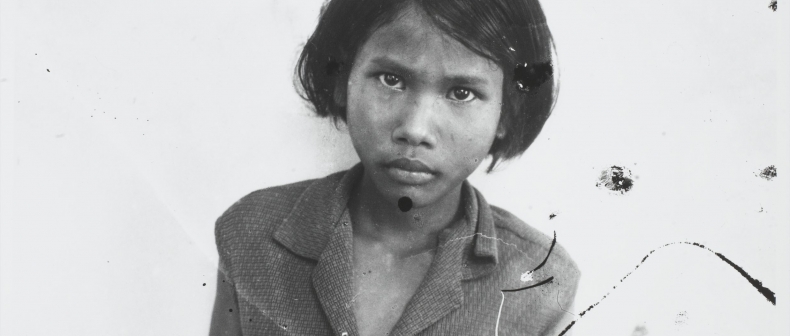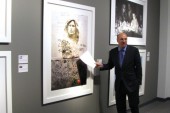
Photos Courtesy of the Tuol Sleng Genocide Museum and Photo Archive Group
“He who protests is an enemy. He who opposes is a corpse.” ~Khmer Rouge slogan
The heart-rending new exhibit at the ROM, “Observance and Memorial: Photographs from S-21 Cambodia” features 104 prisoner photographs from S-21, a high school turned prison in Phnom Penh, Cambodia.
The prisoners in the photos range from infants to the elderly, male and female, most innocent of their alleged ‘crimes’. They were sent there to be tortured, to make forced confessions, to give lists of other ‘traitors’, and eventually to be killed.
Carla Rose Shapiro, from the Munk School of Global Affairs at the University of Toronto, is the associate curator of the exhibit. The challenge lay in presenting enough information to draw in a Canadian audience while not oversimplifying the complexity of what occurred before, during and after the Khmer Rouge regime. The maudlin history of Cambodia since the French colonialist occupation is documented within the exhibit.
Numerous countries attempted to gain control of Cambodia and promises of independence were reneged upon. By the time the US executed their massive bombing of Eastern Cambodia during the late 1960’s and early 1970’s (a greater tonnage of bombs was dropped on eastern Cambodia than the allies dropped during the entire Second World War) the situation was ripe for the Khmer Rouge to seize power.
The Khmer Rouge grew from a relatively small and ineffectual guerilla group to a massive power that took over Phnom Penh and forced a mass evacuation of the city of two million.
They sought to instate a Maoist-Marxist agrarian utopia where rice would be the main currency. “It was essentially an immediate disintegration of individual rights” said Shapiro. The “Angkar” was the absolute voice of power. “The combination of the lack of expertise, the weakened workforce and the poor harvest” culminated in all encompassing disaster. From the onset, mass starvation, overwork and untreated disease decimated the population. Senior Khmer rouge leaders refused to believe that their policies would be incorrect or ineffective, so they blamed everyone around them for the failures of the regime. They blamed the KGB, the Americans, so-called counter-revolutionaries, traitors, and finally members of their own party. No one was safe from their terrorizing system of blame.
There were 196 prisons in Cambodia, 388 stations for mass execution and 19,000 grave pits. Some 2 million were executed.
****
“To destroy you is no loss, to preserve you is no gain.” ~Khmer Rouge slogan
We are guided through the exhibition by a series of black and yellow diagonal lines, creating a tense atmosphere of confinement. Large screens project the rules of the prison and the slogans of the Khmer rouge. It emulates the Kafka-esque nightmare so many Cambodians were thrust into.
The exhibit displays 104 photographs of the dead. At least 14,000 people passed through the doors of S-21, only 23 survived. The photos were snapped when the prisoners were first admitted, often just after having had their blindfolds removed. All of these expressions – disbelief, resignation, exhaustion, fear and shock – give one pause. In one photo, a little girl with olive skin and chin-length hair, identified only as #241, looks to be about eight years old. Her face betrays sheer fear. Her tiny body, wearing its coarse black prison garb, is crumpled against the bare wall. Through careful research, Shapiro was able to determine the identities of four of the people in the series. Their stories are printed alongside their photos.
The collective fate of the subjects wrench these photos away from being mere portraits. The photos were displayed at MoMA in the 90’s as artistic portraiture, which came under severe public controversy. That is not what Shapiro set out to convey in this exhibit.
“These are skillfully created portraits,” says Shapiro. “That’s what makes them compelling as documents. That is one of the primary basis of people’s interest in them. Because as photographs they are very resonant, they are evocative of so many different kinds of emotions, and as you look at the victims, there is a kind of empathy you have for the situation they found themselves in when those photographs were taken. So here it is – a balance between documents of individuals who were condemned to death, and compelling and skillfully created portraits. They’re documents and portraiture. Primarily their function here — and the name of the exhibition is Observance and Memorial — and that this is an honorific. Theres no denying the artistic merit of the portraits. But that is not their primary function here, nor should it be anywhere.”
****
The exhibit (which was developed under close consultation with the Cambodian-Canadian community in the GTA) features a space for quiet reflection under a large wooden Chedei (a traditional monument to the dead). There is an area where survivors of the Khmer Rouge tell their stories within video diaries. Buddhist chants echo in the background exclaiming the ‘Three Marks’: Our lives do not last forever, cannot satisfy us completely, and ultimately do not even belong to us.
There is a distinct call for forgiveness and understanding, in order to heal and regenerate.
“What this exhibit tells you is that – it’s a frightening thought- is that anyone can commit genocide under the right conditions,” notes Shapiro. “And in this exhibit we talk about how in Cambodia, the revolutionary fervor undermined traditional social norms, moral restraints and legal prohibitions. Usually war and conflict paved the way for these kinds of genocides and gross human rights violations. The message here is they were ordinary people, theyre not particularly evil, there’s nothing in their background that inclined them to become mass murderers”
The exhibition is timely in that senior members of the Khmer Rouge are currently on trial for war crimes, crimes against humanity and genocide at the Khmer Rouge tribunal. In July 2010, the former chief of Prison S-21 was found guilty of crimes against humanity and imprisoned.
****
In the visitor guest book, a note is signed in a child’s handwriting: “I wish I could force people to love, but it is worth taking the time to grow love instead.”
And then, a quote by Thomas King: “The truth about stories is that that’s all we are.” Thank you for sharing this story.
Observance and Memorial: Photographs from S-21, Cambodia is at the Royal Ontario Museum in the Roloff Beny Gallery, Micheal Lee-Chin Crystal, Level 4 til March 10, 2013. For more information, visit here.
____
Tiffy Thompson is a writer and illustrator for the Toronto Standard. Follow her on Twitter at @tiffyjthompson.
For more, follow us on Twitter @TorontoStandard and subscribe to our newsletter.














